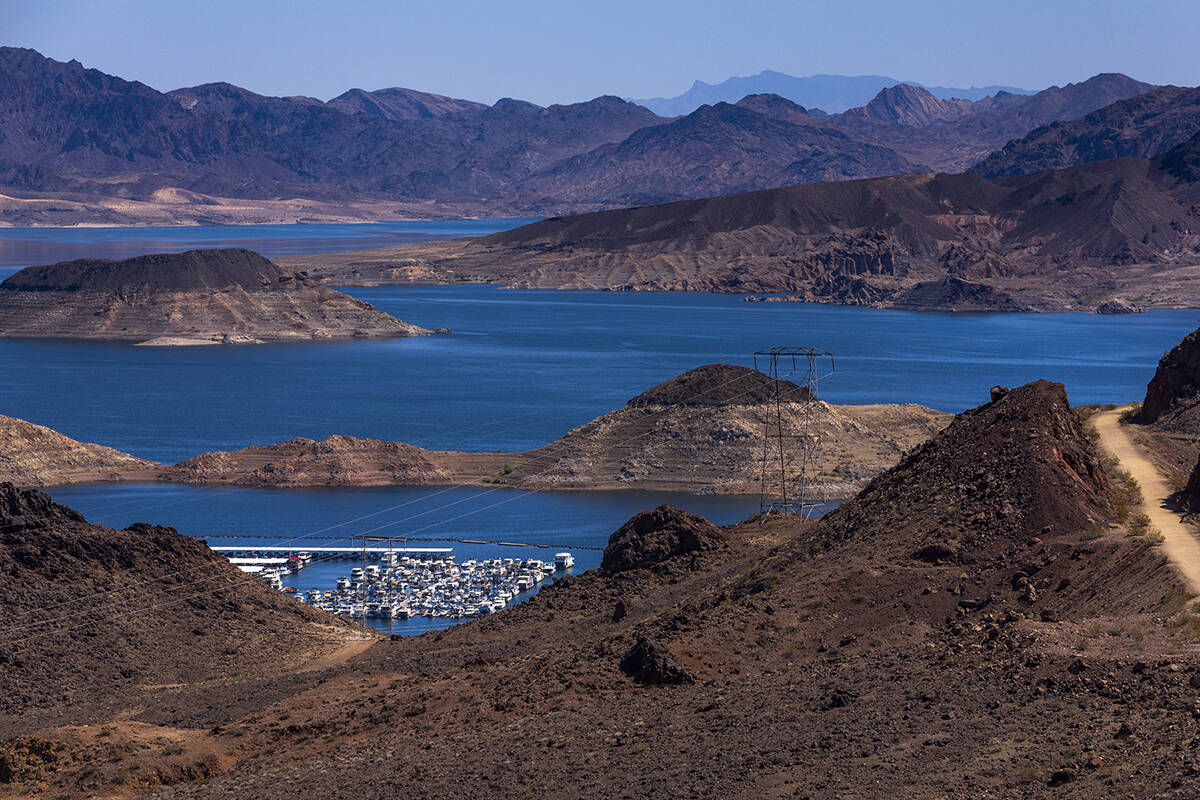Lake Mead’s water woes deepen: Nevada’s share slashed once again
Nevada will face a 7 percent cut in its share of the Colorado River based on a reservoir projection released Friday, marking the fifth year in a row of cuts in an era of concerning and increasing shortage.
As seven states squabble over the future of how 40 million people share the river, all signs point to less water in Lake Mead, Southern Nevada’s primary water source. And Friday’s projection from the U.S. Bureau of Reclamation affirms that by June 2027, Lake Mead is likely to fall to its shallowest level on record since the reservoir was filled in the 1930s.
“This underscores the importance of immediate action to secure the future of the Colorado River,” said David Palumbo, acting Reclamation Bureau commissioner, in a Friday statement. “We must develop new, sustainable operating guidelines that are robust enough to withstand ongoing drought and poor runoff conditions to ensure water security for more than 40 million people who rely on this vital resource.”
Ahead are tough choices and lingering questions about how the West can live with less, said Celene Hawkins, Colorado River program director with The Nature Conservancy, an environmental nonprofit.
“No one loves it from any angle because we’re all having to use less in the basin,” Hawkins said. “This is not an anomaly, and it’s showing the urgency for us to come together as a basin.”
Is Las Vegas equipped for the future?
To prepare for such a sharp decline in reservoir storage as snowmelt from the Rocky Mountains fails to deliver, Southern Nevada has been proactive about stretching its portion of the Colorado River.
Almost every drop of water used indoors is recycled and sent back to Lake Mead through extensive wastewater treatment.
Other sometimes controversial measures to reduce outdoor water use include charging high-use customers excessive use fees, providing rebates for homeowners to rip out their grass, and removing grass across the valley that a committee of experts has deemed nonfunctional.
And the measures have delivered some results. The Southern Nevada Water Authority announced Thursday that consumptive water use from January to July — water that isn’t recycled — is down to 39 billion gallons. That’s 2 billion gallons less than the 2022-to-2024 average for water use in that period.
In a statement, water authority spokesman Bronson Mack pointed to climate change as the region’s biggest challenge. Warmer temperatures cause the atmosphere to suck up more water meant for Lake Mead, and less rain has led to drier soils doing the same along the river.
“As the smallest user of the Colorado River, Nevada has reduced its consumption of Colorado River water by 36 percent over the past two decades,” Mack said. “The Bureau of Reclamation’s recent study underscores the impact that climate change is having on the river system and the critical importance of broad conservation strategies throughout the Colorado River Basin.”
Long-term water resource planning that considers Southern Nevada’s massive projected growth has been underway for decades, with rainy day water banked in Las Vegas’ groundwater aquifers, for instance.
Details sparse on state negotiations
The hydrological reality of the Colorado River Basin highlighted on Friday is underscored by a tense negotiation process in which seven states are running out of time to come to an agreement.
Current governing guidelines for how states share the river expire at the end of 2026, and negotiators have been less than forthcoming about specifics on interstate talks.
The most recent news is that the Lower Basin states of Nevada, California and Arizona are mulling a so-called “divorce” from the Upper Basin states of Colorado, New Mexico, Utah and Wyoming. Releases from Lake Powell into Lake Mead would be based on a three-year average of levels at Lees Ferry, Arizona, though no clarity has been offered on what a release structure could look like.
“It’s all in the details, which, of course, are the hard part,” said Haley Paul, Arizona policy director at the Audubon Society, a nonprofit dedicated to the habitat and health of birds. “Even if there’s still disagreement about the numbers, we have to acknowledge the reality that this river has less to give.”
‘We cannot afford to delay’
On several occasions, Interior Secretary Doug Burgum and his staff have publicly indicated the U.S. Department of Interior’s willingness to decide for the states, if they fail to reach a consensus. That messaging was echoed in Friday’s announcement of the projection.
Scott Cameron, acting assistant secretary for water and science, has told state policy heads that the details of a preliminary agreement need to be submitted by mid-November, and a final one must come by February.
“The urgency for the seven Colorado River Basin states to reach a consensus agreement has never been clearer,” Cameron said in a statement Friday. “We cannot afford to delay.”
Paul, who sits on the Arizona governor’s Water Policy Council and regularly testifies at the Arizona Legislature on water issues, said the Colorado River Basin’s history of collaboration between states must continue.
“We all need our fair share of the water, but we also need to take our fair share of the cuts,” Paul said. “We’re all in this space together, whether you live in Las Vegas, Phoenix, Denver, the Front Range or the Western Slope. This is all of our river, and the more we need to be working together, the harder it is to work together.”
Contact Alan Halaly at ahalaly@reviewjournal.com. Follow @AlanHalaly on X.


















